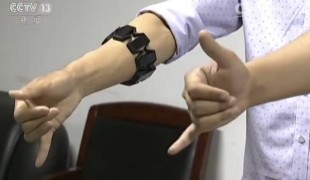- 8405
- 515
- 13
- 9
- 0
- Help Ukraine
About the solution
It was the lack of solutions that made Toby create his own device to help him communicate. At the time, the traditional method was the alphabet card. But this would take a lot of time, as the user had to take a long time to go through all the rows and letters to form words.
After some intense physiotherapy and rehabilitation, Toby, who was an engineer, was able to gain some movement in his hands. That’s when he had the idea to build a portable communication aid - the Lightwriter - a typewriter which instead of typing on paper, typed the message on an LCD display.
The Lightwriter consists of a text-to-speech device. The user types a message and the message is then displayed on two displays - one facing the user and the other on a second outfacing display, for the other person to see. There are several version of this device, and they are available in several European languages.
This innovation can be used by people who have speech impairment or speech loss following laryngectomy, tracheostomy, stroke, head injury, or with progressive neurological diseases such as Motor Neurone Disease, Parkinson's Disease, Multiple Sclerosis, Huntington's Chorea and also Cerebral palsy.
The inventor created this device, at first, for himself. But when he realised that there were a lot of people in his situation, who struggled to communicate, he started manufacturing his gadget so he founded his own company - Toby Churchill Limited - in 1973.
Adapted from: https://bit.ly/2LGpUKn
More info: https://www.abilia.com
This solution shall not include mention to the use of drugs, chemicals or biologicals (including food); invasive devices; offensive, commercial or inherently dangerous content. This solution was not medically validated. Proceed with caution! If you have any doubts, please consult with a health professional.
DISCLAIMER: This story was written by someone who is not the author of the solution, therefore please be advised that, although it was written with the utmost respect for the innovation and the innovator, there can be some incorrect statements. If you find any errors please contact the patient Innovation team via info@patient-innovation.com
-
-
705
-
0
-
11213

Girls create translation armband for the deaf
COMMUNICATION: Communicating, whether by speaking, listening, or other means
Social interaction
Congenital Deafness
Hearing Disorders
Ear and Labyrinth Disorders
5 Senses support devices: (glasses, hearing aids, headphones...)
Assistive Daily Life Device (to help ADL)
Body-Worn solutions (Clothing, accessories, shoes, sensors...)
Hearing loss or ringing in the ears (tinnitus)
Managing Neurological Disorders
Promoting inclusivity and social integration
Improving Speech and Communication
General and Family Medicine
Neurology
Otorhinolaryngology
China
-
-
-
571
-
0
-
9179

Eye controlled communication devices
COMMUNICATION: Communicating, whether by speaking, listening, or other means
CAREGIVING
Cerebral Palsy
Assistive Daily Life Device (to help ADL)
Assistive Technology access
Recovering cognitive function
Promoting self-management
Managing Neurological Disorders
Promoting inclusivity and social integration
Improving Speech and Communication
Neurology
Ophthalmology
Pediatrics
United States
-
-
-
372
-
0
-
4259

Blind student invents a new way of teaching and learning math
COMMUNICATION: Communicating, whether by speaking, listening, or other means
Studying
Reading
Blindness
5 Senses support devices: (glasses, hearing aids, headphones...)
App (Including when connected with wearable)
Recovering cognitive function
Promoting self-management
Managing Neurological Disorders
Improving Speech and Communication
Neurology
Ophthalmology
United States
-
 en
en